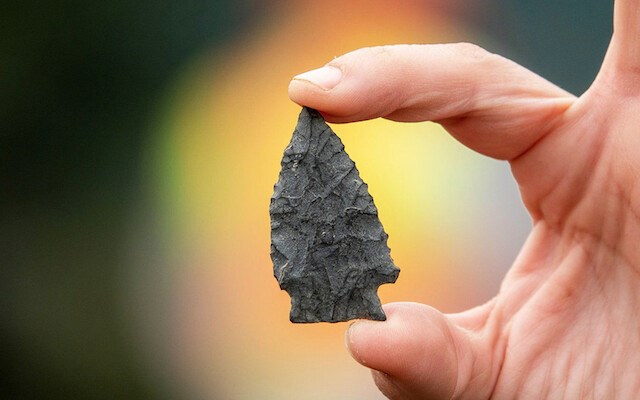- By Rebecca Dyok, Local Journalism Initiative Reporter, WL Tribune / Castanet
Ancient, stone-carved projectile pieces dating back several millennia continue to be exposed this week south of Williams Lake from the large piles of soil moved during work to put in a drainage ditch after a small landslide in the area last year.
A power screen plant was used by staff of Sugar Cane Archaelogy to mechanically sift through the dirt for the hidden gems, unearthing hundreds of finds which date back to when the mid-Fraser River area was occupied by large, First Nations villages.
This site has a southern exposure and a breathtaking view of the south-end waters of Williams Lake and the current community of Sugar Cane, home to about 350 members of the Williams Lake Indian Band (WLIB).
At her office located at Yorston Street in downtown Williams Lake on June 1, Sugar Cane Archaeology archaeologist Whitney Spearing showed three artifacts she said highlighted the recovery efforts over the last couple of days.
An intact arrowhead which she said is one of the oldest to have been recovered is believed to be from the Nesikip Period between 7,500 to 6,000 BP (before present). After being hafted onto an arrow or spear the arrowhead was used as a projectile weapon to hunt small mammals or birds.
This period, Spearing said, is associated with the development of a unique, cultural system including the use of micro-blades and notched projectile points.
“Being able to find a Nesikip point is like finding a needle in a haystack,” she said. “To my knowledge there is no other early Nesikip site in the Williams Lake area. There is one very old site up around the Soda Creek area so we do know that this may be one of two very, very old sites in the area.”
Thousands of artifacts varying in size had already been discovered at the Williams Lake site that was initially identified during the 2016-2019 Highway 97 four-laning project. Even more waited to be recovered from the terrain stabilization and erosion work last year.
Spearing said COVID-19 restrictions dashed their original plans of hosting a community archaeology day in which community members, elders and youth would help screen the piles for artifacts.
Not willing to leave hundreds of artifacts unrecovered, the Williams Lake Indian Band provided up to $25,000 to rent a power screening plant for one week from Abbotsford in order to process the soil with the help of an excavator and several field assistants.
Likely the oldest projectile point ever recovered in Williams Lake and surrounding area, the piece was dated through a detailed examination and comparison with known cultural sequences for the Interior Plateau. Hard carbon dating which will further confirm the age of the point through a U.S. lab has currently been delayed due to the pandemic.
Also recovered with the help of the power screening plant was a point from the Shuswap Period of 3,500 to 2,400 BP, and a point from the Kamloops Period which is between 1,200 to 200 BP.
“What it really shows is the range,” Spearing added. “There’s over, give or take, 6,000 years worth of history at that site which increases our understanding. We initially thought the site was about 4,000 years old and now we know there’s at least an older component.”
Monday, June 1 was the last day of operation for the power screening plant which Black Press Media unfortunately did not get to witness in action as crew members at the site near Sutton Drive worked to unclog the machine from rain-saturated soil.
Stripped of the artifacts, the soil piles will now be leveled and hydro-seeded.
All of the artifacts, including the approximate 3,200 pieces discovered last year, will eventually be displayed at the WLIB Band Administration offices at Sugar Cane, which is under construction.
The new, 18,000 square foot building was the vision of current Chief Willie Sellars’ predecessor and mentor, former Chief Ann Louie.
“She dreamed of bringing our organization together under one roof in an environment that would inspire our staff and create pride in our community,” Sellars said.
Read more from Castanet



